Web 2.0 has changed many aspects of the modern world, and fundraising and philanthropy is no exception. From the tidal wave of tech tycoons committing to the Giving Pledge to the rise of crowdfunding (and a bevy of potential platforms for a crowdfunder to choose from), soliciting essential funds has more avenues than ever--and more potential challenges along with them. This week's throwback rounds up numerous articles that provide time-tested wisdom on how to navigate in the new world of web-based fundraising and philanthropy.
Kickstarter Reaches Major Milestone
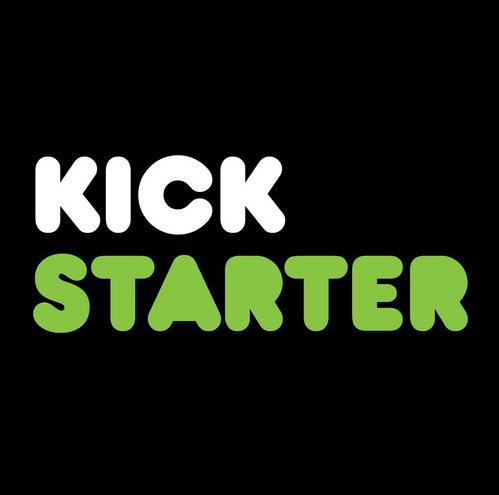 Depending on your perspective, the following news is either a cause for celebration, or a sobering reminder of the state of federal funding for the arts in America. Or perhaps both.
Kickstarter, the funding platform for thousands of arts and other creative projects, announced last week that it is projected, through its website and thanks to thousands of contributors, to be on track to receive over $150 million in pledges in 2012, by far its biggest and most successful year to date.
Depending on your perspective, the following news is either a cause for celebration, or a sobering reminder of the state of federal funding for the arts in America. Or perhaps both.
Kickstarter, the funding platform for thousands of arts and other creative projects, announced last week that it is projected, through its website and thanks to thousands of contributors, to be on track to receive over $150 million in pledges in 2012, by far its biggest and most successful year to date.
This is wonderful news for the arts community, and will help thousands of artists get their projects off the ground. However, the amount does represent a milestone of sorts: while substantial in its own right, the $150 million figure also surpasses the entire 2012 annual budget of the National Endowment for the Arts (NEA), a federally funded program with the might of the United States government behind it.
So it begs the question: as sites like Kickstarter grow in popularity, and help steer more funds to specific arts projects, does federal funding for the arts carry less significance going forward?
We’re big fans of Kickstarter here at Tech in the Arts, and have written about the site’s innovative funding platform and some of the better projects that it has featured. For those who are unfamiliar with Kickstarter, a quick primer: people can post projects online, ranging from art to fashion, film to music, photography to theater, and request donations to get the projects running. The people responsible for the projects outline what they hope to accomplish, how much money they need, and can offer incentives for people to donate money, like free tickets or exclusive merchandise, depending on the amount donated. In the end, if the project fails to reach its fundraising goal (usually within a couple of weeks), no money is exchanged, and the project fails.
As it relates to the juxtaposition of the two entities, first a few caveats. Projects from outside the United States are featured, so the money in question is not confined just within our borders. Second, the site is on track to secure $150 million in PLEDGES in 2012, which does not guarantee funding. According to the site, a little over half of projects fail to meet their fundraising goals, meaning funds for those projects do not change hands. However, with people around the world willing to contribute that much money, it does represent a significant milestone in the arts community.
I wrote last week about the 2013 funding request for the NEA in President Obama’s budget, and welcomed the news about the funding being increased for the new year. However, even with the increase, the budget has failed to increase with the rate of inflation, and is actually a decrease from the early 1990’s, when the budget was in the range of $180-185 million per year.
However, as budget deficits climb and the debt reaches new heights each year, the axe seems to fall on what’s referred to as “discretionary” spending, or spending that’s not mandated by existing laws, first, and that includes programs like the arts, education programs, and public service organizations. This has especially been true in recent years, with calls by some in Washington to drastically cut discretionary programs and cap them from future increases.
As I talked about last week, the NEA is an essential resource for arts organizations, after school programs, schools and community groups who depend on federal programs to survive. Few of these groups generate the amount of internet excitement as the projects on Kickstarter, and cannot rely on social media or online funding mechanisms to continue. Their continued existence rests largely with the help of their local communities, state and local organizations, and most importantly, the federal government.
My concern is that with sites like Kickstarter providing a mechanism for taxpayers to select the individual projects they would like to see funded, the desire to continue to fund the NEA and other arts programs will diminish. Why, after all, have taxpayers pay for a central agency like NEA when individuals can contribute to the projects in their community, or the projects they share an interest with, instead of some program or group they have never heard of?
The NEA has been targeted for elimination in recent sessions of Congress, but thankfully it has survived. Even though the advent of online fundraising tools has provided a steady source of pledges and funding for arts projects, the backbone of arts funding continues to be at the federal and local levels, and any decrease or entire elimination of funding would have a catastrophic impact on artists, the arts community, and arts lovers everywhere.
Another way to look at it this: with the advent of sites like Kickstarter, funding for the arts is increasing, and is becoming a wildly successful endeavor. Last year, Kickstarter received over $90 million in pledges, with several projects hitting the $1 million mark. This is NEW money coming into the arts community, and it deserves to be celebrated.
The ideal, however, is a world where both funding mechanisms continue to move forward, and serve the unique niches they cater to: Kickstarter to the up-and-coming and innovative film/music/theater/art projects and NEA for the community-based groups and local arts organizations.
Congratulations are in order for our friends at Kickstarter, with many more years of continued pledges and success moving forward. It is my hope that the same kind of success and impact continues with NEA, as it faces significant hurdles in Congress to secure future funding.
Crowdfunding for the Arts
- Basics: We’ve talked about Kickstarter before and it is one of the most popular crowdfunding tools. Users have two months to raise funds and provide rewards to their patrons. Kickstarter’s guidelines specifically state you cannot use Kickstarter to fund a charity - you can, however, use it to fund projects for a non-profit. For example, No-Space of Brooklyn used Kickstarter to fund the move to and costs associated with their forced relocation.
- Pros: Kickstarter has an “all or nothing” platform, if funds are not raised within the 60 day limit, all pledges are dropped. Kickstarter is well known and a fairly safe bet for those looking to fund their first project.
- Cons: The project-centric ideology limits what can be crowdfunded. Also, Kickstarter uses Amazon Payments. While Kickstarter itself does not require those creating projects to be US citizens, Amazon Payments does, which makes Kickstarter out of the reach of international organizations.
- Fees: Kickstarter charges a 5% fee to successful projects. There is also a 3-5% fee associated with credit card transactions on successful projects.
- Basics: USA Projects is another crowdfunding source we’ve discussed before, and it is a project of USA Artists. Potential projects have three months to raise the funds or receive nothing. The Project sponsors “new creative efforts by accomplished artists across the country” and has raised over $1 million so far. All suggested projects are vetted by artistic experts in the related field.
- Pros: USA Projects has a strong institutional background with USA Artists, allowing it to have a gift-matching component, and the average donor gives more than Kickstarter users. All donations are tax-deductible, and artists offer perks for donating.
- Cons: USA Projects only accepts artist members who have previously received a grant or award from their partner and recognized organizations as an individual artist.
- Fees: 19% of all donations go to USA Projects “for use in furthering its general charitable and educational purposes.”
- Basics: IndieGoGo touts itself as “the world’s leading international funding platform”, and is open to “anybody with a great idea”. Projects are not curated. Users have up to 120 days to reach their goal, but unrealized goals still receive the pledged funds.
- Pros: Donations to non-profit organizations on IndieGoGo are tax-deductible, different donor levels have perks related to the campaign. Analytics tools allow campaign managers to track where/who funds are coming from, as well as capture contact information from funders. Anyone can use IndieGoGo for anything, which is has unlimited possibilities. IndieGoGo also has partnerships with non-profit organizations that fiscally sponsor projects.
- Cons: No vetting process on campaigns means your next big, great idea may not carry as much weight for donors as a website where projects are curated. Also the website caters more to individual artists’ projects than arts organizations - arts campaigns are not listed under “Causes” unless they have an educational component.
- Fees: IndieGoGo takes 4% of the money your project manages to raise, if your goal is met. Should your project fall short, IndieGoGo takes a 9% cut of funds raised. International campaigns may have higher fees.
- Basics: RocketHub is a crowdfunding platform for anyone who would like their creative work to be funded, developed or distributed. RocketHub has two levels of fundraising, one is a crowdfunding tool open to anyone. Campaigns have between 15 and 90 days to be funded, unrealized goals will still be funded, but met goals have rewards within RocketHub. The second is called a “LaunchPad Opportunity”, which is a reoccuring vetted submission process. Projects chosen receive an opportunity that will advance their business or campaign beyond simple fundraising (for example, the winner of the LaunchPad Opportunity will work with an expert publicist on generating buzz for their project). A team of judges at RocketHub examines all submissions, and Facebook users vote to help decide which projects to put on the website to fund.
- Pros: Successfully funded campaigns on RocketHub allow the campaign creator to submit 5 entries to their LaunchPad Opportunities without a cost. RocketHub has partnerships with non-profit organizations that fiscally sponsor projects.
- Cons: RocketHub does not have a specific “Art” category, although individual projects could fit well into their other categories.
- Fees: For crowdfunded fees, RocketHub charges 4% of the money you raise if your goal is met. For unfunded projects, the fee is 8%. RocketHub also charges a 4% transaction fees for credit card charges. For first time submitters to a “LaunchPad Opportunity”, there is a submission fee of $8. Those who have a project successfully crowdfunded do not have this fee.
IndieGoGo and RocketHub work outside the states, but there are other crowdfunding tools internationally. There are also tools like Philanthroper, which is a daily deal crowdfunding site for non-profit organizations. There are resources for staying on top of crowdsourcing trends, too. Ultimately, an individual or organization has to consider what type of crowdfunding campaign will work for their needs before deciding on one. If there are any other crowdfunding topics or questions you’d like answered, leave a comment, and we’ll see how we can help.
In An Era of Budget Austerity, Public Art Projects Take on Increased Impact
 One of the unfortunate realities of the current economic climate is that with so many Americans unemployed, and others saving money instead of using it to purchase goods and services, the states, counties and municipalities that rely so heavily on sales tax collections are faced with fewer tax collections and larger annual budget deficits. With most local governments required to balance their budgets every fiscal year, they are forced to cut spending, lay off workers and delay investment on previously planned projects.
Since the 2007 recession, this trend has spread towards nearly every corner of America. As it relates to the arts community, investments in public works of art, like sculptures, statues and murals, have been shelved due to budget cuts. However, at the same time, a rise in grassroots public art projects, funded using online crowdfunding programs, have helped deliver quirky and imaginative works of art to cities nationwide, bringing a small sense of civic pride back to areas devastated by the economic downturn.
One of the unfortunate realities of the current economic climate is that with so many Americans unemployed, and others saving money instead of using it to purchase goods and services, the states, counties and municipalities that rely so heavily on sales tax collections are faced with fewer tax collections and larger annual budget deficits. With most local governments required to balance their budgets every fiscal year, they are forced to cut spending, lay off workers and delay investment on previously planned projects.
Since the 2007 recession, this trend has spread towards nearly every corner of America. As it relates to the arts community, investments in public works of art, like sculptures, statues and murals, have been shelved due to budget cuts. However, at the same time, a rise in grassroots public art projects, funded using online crowdfunding programs, have helped deliver quirky and imaginative works of art to cities nationwide, bringing a small sense of civic pride back to areas devastated by the economic downturn.
We here at Technology in the Arts have previously looked at the crowdfunding website Kickstarter, which serves as a simple way for artists to solicit and accept donations for arts projects from people online. The way the site works is simple: an artist has an idea, he/she sets a fundraising goal that they wish to achieve, and they have three months to reach that dollar amount. The artist will often design a list of rewards for donors to motivate them to donate, and if the project does not reach its fundraising goal by the end of the three month time period, no money is spent and all money is returned.
Kickstarter features projects from many different categories, including theater, music, games and fashion, but its most unique and inspiring pieces come from the world of art, and more specifically, the projects that don’t belong to a gallery or museum, but instead to the people of a particular city. Projects that serve as public goods, ones that all people, from residents to tourists, can enjoy, are the ones I find the most inspiring and important.
Last week, The Atlantic Cities (one of my favorite city/urban policy sites) took a look at six successful and wildly unique public arts projects that have cropped up around the country. These projects, along with the thousands of others featured on Kickstarter, offer a fascinating glimpse into how ordinary people are using the cities around them to express their artistic creativity.
The city of Grand Rapids, Michigan, no stranger to the economic downturn, saw one of the more unique projects I came across: a slew of metal monkeys hanging from a pedestrian bridge near the city’s downtown. The project, titled “Metal Monkey Mania,” successfully completed funding last month.
Across the country, in West Berkeley, California, a set of large ceramic tiles by artist Juana Alicia, designed for a low-income housing complex, were finished, but sitting in boxes because she did not having the funding necessary to install them. Enter Kickstarter, and last week, she reached her goal of raising over $5,000 to finish the project. The beautiful tiles will be hung in the near future.
While not a physical piece of art, one of my favorite public art projects featured on Kickstarter puts everyone who comes across it in the position of artist extraordinaire. Artist Katie O’Beirne has left disposable cameras in New York City and other cities around the world for a few hours at a time, letting regular people who come across the cameras to take pictures of whatever their hearts desire. Taking a look through the images offers a fascinating look into what people choose to show in their contributions. Katie is compiling the pictures and hoping to turn them into an art show in the near future (as of the time of this writing, there is still time to donate to the project and make her dream a reality).
South of the border, in Puebla, Mexico, a group of independent artists have been painting beautiful murals across their city in an effort to celebrate the town’s rich heritage. The group has plans for over two dozen more murals, and has their own Kickstarter page dedicated to bringing more artists to the area that is currently very close to its target of over $29,000.
Nobody will mistake any of these projects as a perfect substitute for a large scale government or privately funded works of art. However, many of the projects featured serve as an inexpensive, quirky way to bring a sense of culture and artistic expression to cities large and small across the country that are grappling with severe budget cuts and austerity measures. And while the economic downturn has forced cities and states to cut back on the kind of 21st century arts projects that many of us in the arts community would love to see, the rise of crowdfunding sites such as Kickstarter and the entrepreneurial spirit of artists everywhere have shown that technology can help bridge the gap until the economy gets back on the right track.
(Photo credit: Colectivo Tomate)
Peer to Peer Fundraising in the Digital Age
Back in the day, peer-to-peer fundraising was done with phone calls, letter-writing campaigns, and in-person visits. Now we have a whole new universe of not only digital communication, but digital relationships. Recently, I came across a cool infographic from Blackbaud that illustrated the power of harnessing online social networks to raise money for charity. It got me thinking- what are organizations doing to take advantage of this?
Peer to Peer Products
Peer to peer fundraising tools offered by Blackbaud (Friends Asking Friends) and Convio (Team Raiser) enable team members and participants to set personal fundraising goals and then go about asking friends and family for donations, the deadline for raising funds usually being an organizational event (primarily races to cure diseases). In fact, according to the Chronicle of Philanthropy, all of the top five P2P Giving organizations in 2010 were health organizations (for the top 25 online giving orgs of 2010 view slide 8 here).
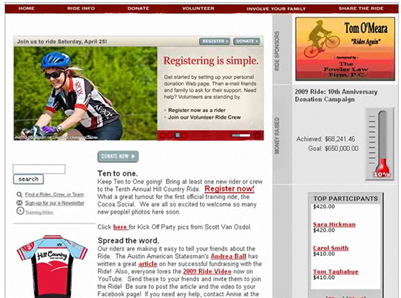
- Convio's Team Raiser

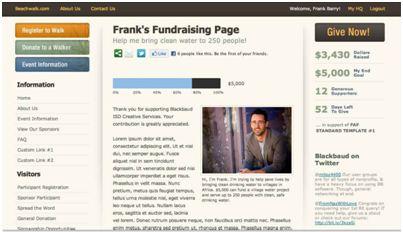
- BlackBaud's Friends Asking Friends- thanks Frank Barry!

If you put on these participant-heavy events, here’s a post about 3 ways to add new event participants. But according to a webinar by Blackbaud on Tuesday, you don’t have to have an event in order to use these tools. Organizations are using them both with ongoing fundraising and with virtual or digital events as well.
Website Tools
Both the Salvation Army and the World Wildlife Federation have cool things that are like the peer to peer tools above, but are designed for ongoing fundraising. The Salvation Army has an “Online Red Kettle”. You can either start your own red kettle, donate to an existing one, or send an eCard to your friends (via email) urging them to support one. If you set up your own, you can have your own fundraising meter, banner ad, or Facebook app.
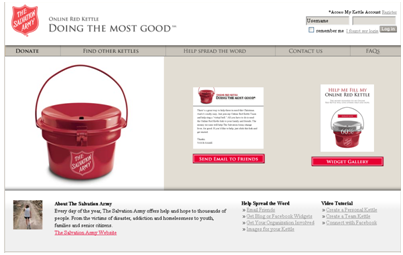
- Online Red Kettle

On the WWF’s site, you can search for or make a super-cute Panda Page (it can be for any animal), then email it to your friends and family. As of right now there weren’t any social media plug-ins on the page.
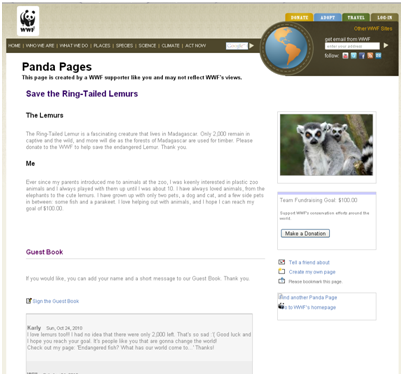
- World Wildlife Federation Panda Page

Another way to configure your website to encourage peer-to-peer fundraising (also suggested by Frank Barry and Steve MacLaughlin of Blackbaud) is to immediately prompt online donors to share with their social networks when they make a gift, instead of only receiving a regular confirmation page or email. Use Facebook and Twitter plug-ins (like and share buttons, retweets etc) to make it simple for them to share with their networks.
You can also embed those same plug-ins in different areas of your website. Enable somebody to “like” a concert, or retweet a story about your outreach program.
Facebook Causes
Causes has alternately been held up as a model for success and derided for not delivering on its promises. The basic idea is that it allows anyone to create an advocacy group, or “cause”. This cause can then raise funds to donate to a charity. One of the most successful causes is The Nature Conservancy, which has raised over $400,000. An arts success story is Keep the Arts in Public Schools, created by Americans for the Arts, which has raised almost $50,000. People can become members of the cause, donate, tell friends, and “give a minute” by watching and participating in ads that earn money for the cause.
Aaron Hurst of Taproot has been a critic of Facebook Causes since his organization devoted $3,000 of staff time to creating their Cause shortly after Facebook launched the feature. They have received only $60 in return to date. Is Causes a rip-off or a revolution in fundraising? The jury’s still out, but it’s my guess that the different results are due to a combination of knowing how to facilitate peer-to-peer fundraising well, an organization’s existing fan base, and the type of cause. It’s interesting to note that at the Nature Conservancy, social networking was never primarily about raising money- it was “first and foremost a tool for brand and reputation,” said an organizational representative in this 2009 Washington Post article.
Kickstarter
Much has been written about Kickstarter and its cousins, IndieGoGo and RocketHub (among others- check out Pat’s article from last year). And certainly anyone using these tools knows that it’s all about mobilizing your social network. It’s really better suited to specific projects than ongoing fundraising, however. And unless you are able to get your supporters to in turn appeal to their own friends, you are probably going to be asking the same people you always ask anyway.
According to a recent article from NPR, Kickstarter has raised over $50M for creative projects since launching in 2009 and currently attracts $2M in pledges each week for projects.
Check out this Mashable article on other social fundraising alternatives.
The philosophical side
There’s a lot more to this than just raising more money. It’s also about building donors of the future, and increasing not just donations but engagement that will later lead to donations.
On Wednesday, the Case Foundation hosted the Millennial Donors Summit to talk about millennials’ approach to charitable giving. A lot of the points that were made apply not only to millennials, but also to peer-to-peer and social media fundraising. The following is excerpted from Katya’s Non-Profit Marketing Blog:
- It’s not about telling millennials to support you; it’s about creating a vested interest in what you are doing with joint ownership. Let millennials manage your community, design your logo or otherwise be an active partner in what you seek to accomplish.
- At some point, you have to build an army. You can only sell something yourself so many times—you need your community doing it for you, performing the heavy lifting. So give them ownership.
- To be trusted on the web, be an individual, not an organization.
- Look for the small yes.
Something that Frank and Steve mentioned in their webinar this week is that it’s more important to tell a compelling story than it is to make the ask when using social media to fundraise. They gave examples of YouTube videos where the ask was a subtitle. The story is what gets people interested.
Also, give them something to do besides donate. Encourage them to like your page, share the link or video, comment, or even answer a question (like at Free Rice) or send mom a card.
Many of these examples are from very large organizations that have teams of people to create these web tools. But these ideas can be applied on a smaller scale. How have you empowered your constituents to raise money and awareness for you? Do you know of arts organizations who are doing it successfully?
Kickstarter: funding for (and by) the masses
Crowdfunding websites are a simple way for artists to solicit and accept donations online. One of the best-known sites is Kickstarter, which hosted the record-breaking crowdfunding of Diaspora. With Kickstarter, you set a fundraising goal and have three months to achieve it. If you reach your goal within three months, you keep the cash. If you don’t, the funds are returned to your backers. You design a menu of rewards to motivate backers to give. And, you keep 100% of ownership over your project -- an important consideration for artists dealing with copyright and distribution issues.
Helen DeMichiel, who funded a series of webisodes with Kickstarter, says the all-or-nothing structure is a great motivator. “You have to hustle,” she explains, and your backers get caught up in the excitement.
A previous project backer and current project starter, Tirzah DeCaria points out that most projects are funded largely by backers within the artist's existing network. She advises artists to look at Kickstarter as an opportunity to consolidate and mobilize your network rather than as a tool for reaching large groups of new fans. Of course, Kickstarter isn’t for everyone. The site is curated, and in addition to an application process, projects must have a U.S. address and a U.S. bank account. And there are the guidelines.
In a quick scroll through Kickstarter’s current projects, I came across many projects posted by individual artists or small groups, as well as projects by a design studio, a non-profit performance company, and a video game developer. Kickstarter clearly doesn't exclude businesses, but established organizations aren't the primary users. If your organization is considering a project, Joe's post on micro-donations has some good thoughts and advice. And, again, consult Kickstarter's guidelines.
Other crowdfunding sites for artists:
- Projects on IndieGoGo can be based anywhere in the world. Unlike Kickstarter, the site isn’t curated, so projects cover a broad spectrum -- creative endeavors, causes, and entrepreneurial work. And, IndieGoGo is not an “all-or-nothing” enterprise. You can keep any funds you raise along the way. IndieGoGo also has several innovative partnerships, including a fiscal sponsorship program through Fractured Atlas and the San Francisco Film Society.
- RocketHub is another “all-or-nothing” crowdfunding site geared toward artistic and creative projects. RocketHub is not curated, though projects must be legal and “in good taste.” You must have a PayPal account to start a project.
What is your experience with crowdfunding art? Should established organizations stay out of it or join in the fun?






